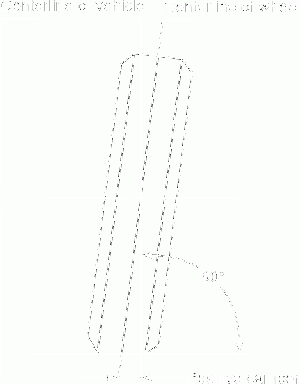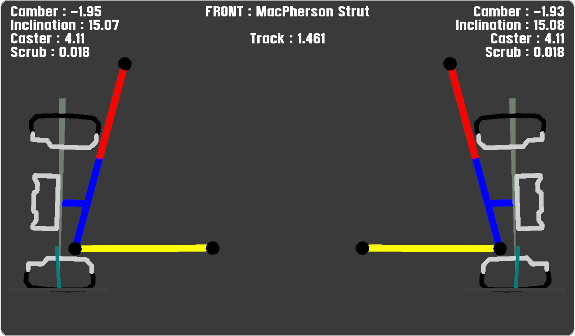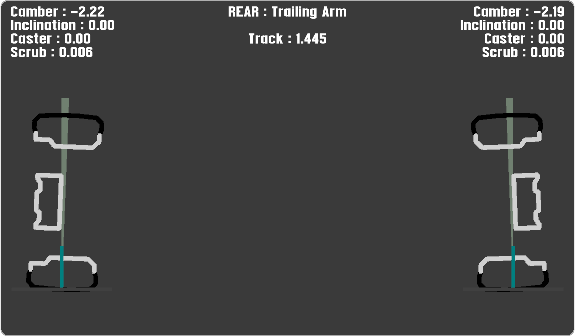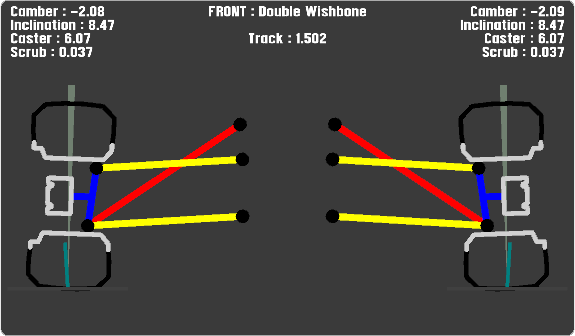テクニカルリファレンス
ステアリングとサスペンションのメカニズム
ステアリングジオメトリ
"フロントアライメント"とは、車輪とサスペンションとステアリングの関係のことを指します。これらの関係はステアリングジオメトリと呼ばれる角度を使って計算されます。この角度には、キャンバー角、キャスター角、キングピン傾斜角があります。このページでは、これらの角度の定義とその働きをカバーします。
キャンバー角
車両を前から見たときに、タイヤが傾いている角度のことをキャンバー角といいます。この角度は車両に積んだ荷物などの重さや、サスペンションの動きによって変化します。
前から見たときに、タイヤの上部が外側に傾くようなキャンバー角のことをポジティブキャンバーといいます。反対に、内側に傾くようなキャンバー角のことをネガティブキャンバーといいます。
ホイールの中心を通る線と、上下にまっすぐ引いた2本目の線によって示されます。タイヤと路面が接する部分で交差するようにします。キャンバーは方向制御角であり、タイヤ摩耗角でもある。元来、道路は高いクラウン、つまり中央部が高く、側面に向かって下り勾配になるように造られている。そのため、タイヤが路面に正対するためには、大きなキャンバーが必要であった。タイヤが路面に正対していないと、片側が摩耗し、積極的なステアリング操作のためのグリップが得られないからである。しかし、最近の道路はクラウンがほとんどなく平らに作られているので、その分キャンバーが少なくて済む。平坦な道であっても、一般にある程度のキャンバーはあった方がよい。タイヤと路面の接点が、ステアリングナックルピボットの直下により近くなるからである。これにより、車輪が回転しやすくなり、車輪がバンプに当たったときに車両のサスペンションやステアリングリンケージに伝わるロードショックの量を減らすことができます。また、大きなインナーホイールベアリングにほとんどの負荷がかかります。このような悪い影響を避けるために、車両の設計時にはキャンバー量を慎重に検討する必要があります。タイヤを手で転がしたことがある人なら、コーナーを曲がるのにタイヤを曲げなくてもよいことをすぐに理解できるだろう。タイヤを片側に傾ける(キャンバー)だけで、まるで円錐のようにコーナーを曲がっていく。下図は「ポジティブキャンバー」です。左側にクルマの垂直方向の中心線が見えますが、この中心線からホイールが数度傾いています。もし、ホイールが垂直方向から内側に傾いている場合は、「ネガティブキャンバー」と呼ばれます。
ポジティブキャンバーは、クルマの重さを補うものです。クルマが前進し始めると、クルマの重さでホイールが完全に垂直になるように引っ張られます。もし、ネガティブキャンバーでアライメントを調整すると、車輪はさらに車側に引っ張られることになります。
キャスター角
When viewed from the side of the wheel, the caster angle is the degree to which the kingpin or ball joint tilts forward or rearward in relation to the frame Like the camber angle, the caster angle is also measured in degrees. It is shown by a line drawn straight up and down, as in the figure and then a second line drawn through the centre of the kingpin or pivot points. The caster angle is the angle formed at the point where the two lines cross, as viewed from the side of the vehicle. A good example of caster is a bicycle. The fork is tilted backward at the top. A straight line drawn down through the front-wheel pivot or kingpin would strike the ground ahead of the point where the tyre contacts the road. A wheel mounted in this fashion is said to have positive (+) caster or “just” caster. If the top of the kingpin is tilted forward so that a straight line drawn through it hits behind the point where the tyre contacts the ground, the wheel is said to have negative (–) caster. On a vehicle with axle suspension, caster is obtained by the axle being mounted so that the top of the steering knuckle or kingpin is tilted to the rear. On a vehicle with independent suspension, the upper pivot point (ball joint) is set to the rear of the lower pivot point. Caster is a directional control angle, but not a tyre wearing angle. Positive caster causes the vehicle to steer in the direction in which it is moving. This is called an automatic steering effect; for instance, the forward momentum of a vehicle tends to keep wheels with positive caster in the straight-ahead position. After rounding a turn, this causes the wheels to return to a straight-ahead position when the driver releases the steering wheel. This automatic steering effect is also called self-righting or self-centring action. Positive caster makes the turning of the steering wheel more difficult, whereas negative caster turns more easily, but will cause the vehicle to wander. Caster is the tilting of the front steering axis either forward or backward from vertical as viewed from the side of the car see below.
When the axis is tilted backwards from vertical, caster is said to be positive. Positive caster creates a trailing action on front wheels. When the axis is tilted forward, caster is negative, causing a leading action on front wheels.
ステアリング軸の傾斜
This is the geometric relationship between the Ball Joints and the wheel. Note: The lower ball joint is farther out from the centreline of the car than the upper ball joint.
By drawing an imaginary line between the ball joints and measuring the angle this makes with the true centreline of the wheel, you can determine the angle of steering inclination or the angle the ball joints incline away from centre. The angle of the inclination provides a number of benefits to steering. It increases tyre life, When turning a corner it increases the rate of recovery... When the car is moving forward it makes the steering more stable, but increases the effort required to move the steering wheel.
Tracking: The greatest effect steering axis inclination has on the car is tracking. This is the tendency for the car to go where the front is pointed. This is the result of what happens when the steering knuckle moves. Because of the angle of inclination, when the steering knuckle turns, it tends to lift the car.
The weight of the car forces the axle (Steering knuckle) downward or back into a straight or horizontal angle. This pulls the wheel / tyre back into a line with the body of the car. The car continues the same way it was going.
ショックアブソーバー
いくつかの背景となる情報がこれが何なのかを理解する助けとなるでしょう。
Although not a spring in itself, shockies are an integral part of the spring action, damping the actions of the actual spring, shock absorbers are exactly that, they are devices designed to absorb the shock or bounce generated by bumps. They reduce the action and reactions to fewer contractions and expansions of the coil. This helps to prevent the car from “floating” or the bouncing motion after it hits a bump.
If we have no shock absorbers attached to each wheel to control the compression and expansion of the coil spring, the spring would keep bouncing up and down like a rubber ball till all the energy had been dissipated. A shock absorber is filled with fluid or gas, a plunger connected to the top of the shock, is forced down when the spring compresses.
Through a series of valves, the fluid in front of the plunger is forced into side chambers, slowing or damping, the return of the spring.
Its this alternating up and down motion of the plunger that provides the required damping effect.
スプリング
現代の車に使われているスプリングには4つの基本的な種類があります:
- コイルスプリング
- トーションバー
- エアスプリング
- リーフスプリング
ここでは、LFSのモデルに最も近いと思われるコイルスプリングについて解説します。コイルスプリングはとても長い間使われてきたもので、現在最もよく使われる種類のスプリングです。リアサスペンションにも使われるようになってきました。
Coil springs are specially made from spring steel and heat treated to temper or add spring and strength to them. They are fitted between the frame of the car and a bracket or recess on the suspension member or part of the axle. Front wheel drive cutaway showing the coil spring supports and bump stops and other parts.
スタビライザーバー
Or sway bars as we sometimes call them are not really springs but act as though they were springs. And help in controlling spring action. Confused? Lets look at the diagram and the explanation in more detail.
Sway bars reduce body roll on cornering, perhaps it’s best to describe them as a kind of torsion bar. They reduce some of the twisting action of the frame.
When the car moves down the road with the frame level, the stabilizer bar is at rest. When one side of the frame of the car rises up, like when it hits a bump, the opposite side of the frame rises also.
This movement is counteracted by the stabilizer bar.
The lifting force on one side cause the stabilizer to twist like a torsion bar, creating a downward force at the opposite side. This helps to keep the frame level.
Okay, some of the above is confusing and misleading, I don't want to completely remove it though, so I'll just make my own explanation of how I understand a stabilizer bar to work.
A stabilizer bar is a torsion bar (spring) which transfers load from one side of the vehicle to the other. For example, on entering a left-hand corner, the car will lean to the right and compress the spring on the right of the vehicle. The stabilizer bar is lifted on the right-hand side, and transfers some of this lift (depending on its stiffness) to the left-hand spring, compressing it, which acts to reduce the amount of body-roll.
When travelling in a straight line, a stabilizer bar is actually useless, as a bump that only one wheel hits will transfer to the other side as well, which isn't really helpful. However, when travelling in a straight line, handling isn't a problem, so it's a small price to pay for better cornering.
IFS (独立フロントサスペンション)
Control Arm or Independent Front Suspension allows the two wheels to move up and down independently of each other the diagram above shows how the wheel can move up and down yet not move the frame allowing the tyre to have a level, full contact area.
This is the most common form of front suspension in modern cars and the method LFS is likely modelled upon. Solid axles are generally used in Vintage and Veteran cars and some larger trucks.
The solid axle as shown in the other diagram behaves in the opposite way. I.E. When a tyre hits a bump the whole axle and the frame will lift up, Tilting the opposite wheel and allowing the tyre to lose some contact with the road surface. McPherson Strut type front suspension is a somewhat different approach using a control arm method.
You will see there is no upper control arm present.
Everything else is there: Spring, shock stabilizer and the torsion rod. Being lighter than a normal approach its ideal for smaller cars. With the heavy duty shock and lighter spring the upper control arm is no longer needed.
サスペンション形式
マクファーソンストラット
トレーリングアーム
ダブルウィッシュボーン
|
基本セットアップガイド | 応用セットアップガイド | テクニカルリファレンス | スキン作成 チュートリアル | オートクロスエディタ | ムービー作成 チュートリアル | スクリプト作成 | Host チュートリアル | LFS プログラミング | ファイルフォーマット | |||



